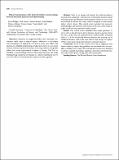| dc.description.abstract | Objectives
Aflatoxins are fungal metabolites that commonly contaminate staple crops in tropical regions. Aflatoxin is a carcinogen and consumption at high-levels can lead to acute liver failure and aflatoxicosis. Multiple epidemiologic studies have shown an association between aflatoxin exposure in infants and young children and growth failure, but strong experimental evidence is lacking. The Trial to Establish a Causal Linkage Between Mycotoxin Exposure and Child Stunting being conducted in Tanzania is a cluster-randomized trial to assess the effect of reduced aflatoxin exposure on linear growth.
Methods
Prior to its design and launch, the multi-disciplinary research team conducted a critical review to determine the most salient ethical questions and dilemmas in the potential conduct of such a study and debated if and how this study could be designed to meet human subject ethical criteria. This critical review included trial protocols, methodologies and historical controversies in the areas of bio-medical, public health and environmental health research.
Results
This critical review identified three major questions: 1) Given what is already known about aflatoxin, should a question about the effect of this toxin on child growth be studied further in human subjects? 2) If the relationship between aflatoxin and stunting can be studied in humans, what is the most ethical study design to employ? 3)What is the most ethical intervention to randomly allocate?
Conclusions
Based on the critical review and in alignment with human subject principles and guidelines, we concluded that it was possible to conduct such a study. The trial and intervention were designed to advance scientific knowledge, maintain a favorable risk/benefit ratio, and respect participants, among other ethical principles. | en_US |

